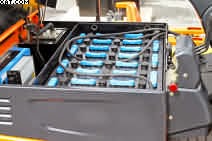Solar storage Batteries can be very confusing?
There are so many different types and brands of batteries on
the market today; it’s no wondering the general public get confused. What is a
Gel battery? What is an AGM battery? What is a free flow lead acid battery, the
list goes on and on. Manufacturers of batteries are always bringing out a new
product, confusing things even more. Consumers who are now building banks of
batteries to store solar power are probably amongst the most confused at the
moment, not knowing and understanding which batteries are the best to use at a
 |
| Typical bank of solar storage batteries |
In my opinion one of the best batteries for use in solar
power storage is the Trojan battery from the USA. These batteries are awesome,
and not too much more expensive than normal lead acid batteries. Trojan have
developed batteries to be used in heavy industry ensuring a maximum battery
life, All that is required is that you add distilled water to the battery cells
at regular periods and do not let the levels dip below the battery cell tops.
Trojan are true deep cycle batteries, which is what you want
in solar battery storage. The Trojan batteries are designed to give you 1.500
cycles at an 80% depth of discharge. These batteries also stand up to high and
low temperatures and therefore are suitable for remote locations and wilderness
conditions. These batteries are designed to optimum performance in conditions
where they may operate in a partial state of charge, given the fluctuations
that occur when pursuing storage from renewable energy applications in
different levels of sun light that may be available to the user.
In many solar battery banks Trojan recommend that you use
deep cycle flooded batteries rather than AGM batteries, primarily because of
the price. Also because Trojan use wide plates in the battery construction,
then the period that the batteries have to be topped up is much further apart,
with minimum battery servicing required.
Trojan batteries have duel container protection
The industrial line of Trojan batteries can be purchased in
the UK from www.batteriesontheweb.co.uk.
They are made up of 2 volt cells that are bundled together or stand alone and
contained in a second container to supply high capacity in 2 volt, 4 volt or 6
volt solutions. The battery casings are made from very tough polyethylene material
and are extremely tough protecting the battery against most type of damage and
acid leaks..
One thing to remember though is that these batteries are extremely
heavy and information about them for solar storage use can be found on their
website…http://www.trojanbatteryre.com/Markets/Renewable_Energy_Residential.html
There are many different brands of this type of battery on
the market and the best advice I can give is to have a look at the products and
the price and come to your own conclusion. All in can say is that Trojan
batteries are a world leader and have a great deal of experience in setting up
different sizes of solar power banks of storage batteries all over the world.
This information can be seen on their website and goes into great detail of the
requirements of the individual communities, including whole island situations
and smaller village situations in countries as far away as Africa and South America.
 |
| A typical trojan battery |
Other company’s products can use AGM batteries. These batteries
also come in to the deep discharge category and are also suitable for the job
of solar energy storage, but a trend that is slightly worrying me, is the use
of so called leisure batteries for the electricity storage purpose.
These batteries have been developed for leisure vehicle
usage. These batteries are usually 110 amp leisure batteries and are very
popular. I do know that some of my customers are buying these batteries for the
purpose of solar storage, but in my opinion they are not the best batteries for
the job. You should be looking at deep cycle batteries in free flow lead acid
or AGM batteries. These will give you a better battery life span and although the
cost of these batteries is much higher they will pay for themselves in the long
run by perhaps doubling their life span when compared to the 110 amp leisure
battery.
Disclaimer
Please note these are the words and opinion of the author
(Eric Roberts) only. Neither the author nor the website can be held responsible
for any errors or omissions. You should seek professional assistance if in
doubt about your choice of battery. The article contains a link to
Batteriesontheweb where you can buy all of the products mentioned.




